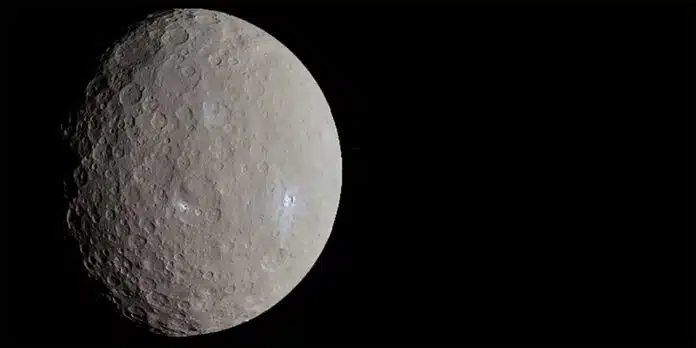
By Pranjal Malewar 28 Sep, 2024
Collected at: https://www.techexplorist.com/ceres-ocean-world-icy-giant/90460/
Since Giuseppe Piazzi spotted Ceres, the largest asteroid in our solar system, in 1801, scientists have wondered about its makeup. Ceres’s surface is full of impact craters, making many think it couldn’t be very icy.
Scientists at Purdue University and NASA’s Jet Propulsion Lab (JPL) suggest Ceres is very icy and might have once been a muddy ocean world. They used computer simulations to study how craters on Ceres change over billions of years.
Scientists believe there is a lot of water ice near Ceres’ surface, and it becomes less icy as you go deeper. People used to think that if Ceres were very snowy, the craters would change shape quickly, like glaciers or flowing honey. However, their simulations showed that ice can be much stronger on Ceres when mixed with a bit of solid rock.
This discovery challenges the previous idea that Ceres was mainly dry. While it was thought Ceres had less than 30% ice, Sori’s team now believes the surface is about 90% ice.
Mike Sori, assistant professor in Purdue’s Department of Earth, Atmospheric, and Planetary Sciences, said, “Our interpretation of all this is that Ceres used to be an ‘ocean world’ like Europa (one of Jupiter’s moons) but with a dirty, muddy ocean. As that muddy ocean froze over time, it created an icy crust with some rocky material trapped in it.”
Using computer simulations, scientists modeled how relaxation occurs for craters on Ceres over billions of years.
Even solids can flow over long periods, and ice flows more easily than rock. Craters on Ceres have deep bowls that create high stress, which then relaxes, making the craters shallower over time. After NASA’s Dawn mission, scientists concluded that the lack of relaxed, shallow craters suggested the crust couldn’t be very icy.
However, the new computer simulations show that ice can flow with just a little non-ice material. This means Ceres could have a very ice-rich crust that hardly flows, even over billions of years, which explains the lack of relaxed craters. The scientists tested different crust structures and found that a crust with a high ice content near the surface, gradually decreasing with depth, best explains the limited relaxation of Ceres’ craters.
Sori said, “Ceres is the largest object in the asteroid belt and a dwarf planet. Sometimes, people think of small, lumpy things as asteroids (and most are!), but Ceres looks more like a planet. It is a big sphere, diameter 950 kilometers, with surface features like craters, volcanoes, and landslides.”
Ian Pamerleau, PhD student, said, “We used multiple observations made with Dawn data as motivation for finding an ice-rich crust that resisted crater relaxation on Ceres. Different surface features (e.g., pits, domes, landslides, etc.) suggest that Ceres’s near subsurface contains a lot of ice.”
“Spectrographic data also shows that there should be ice beneath the regolith on the dwarf planet, and gravity data yields a density value very near that of ice, specifically impure ice. We also took a topographic profile of an actual complex crater on Ceres and used it to construct the geometry for some of our simulations.”
Sori says that because Ceres is the largest asteroid, some estimates of its mass made from the Earth suggested that it could have been any icy object. Those factors made it a great choice for a spacecraft visit.
“To me, the exciting part of all this, if we’re right, is that we have a frozen ocean world pretty close to Earth. Ceres may be a valuable point of comparison for the ocean-hosting icy moons of the outer solar system, like Jupiter’s moon Europa and Saturn’s moon Enceladus,” Sori said.
“Ceres, we think, is, therefore, the most accessible icy world in the universe. That makes it a great target for future spacecraft missions. Some of the bright features we see at Ceres’ surface are the remnants of Ceres’ muddy ocean, now mostly or entirely frozen, erupted onto the surface. So we have a place to collect samples from the ocean of an ancient ocean world that is not too difficult to send a spacecraft to.”
Journal Reference:
- Pamerleau, I.F., Sori, M.M. & Scully, J.E.C. An ancient and impure frozen ocean on Ceres implied by its ice-rich crust. Nat Astron (2024). DOI: 10.1038/s41550-024-02350-4

Leave a Reply